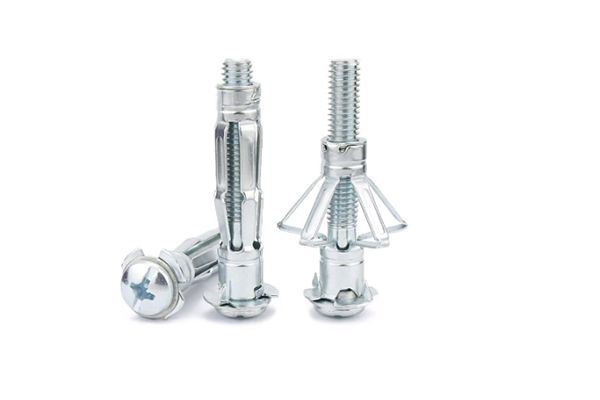This comprehensive guide delves into the world of hollow metal door anchors, focusing on the effectiveness and efficiency of self-drilling screws. Whether you're a seasoned contractor or a company owner venturing into procurement, this article provides valuable insights into selecting, installing, and optimizing the use of these essential fasteners for construction, mining, and tunneling projects. We aim to equip you with the knowledge needed to ensure durable, reliable, and safe installations, improving project timelines and reducing potential complications.
1. What are Hollow Metal Doors and Why are They Used?
Hollow metal doors are a staple in commercial, industrial, and institutional buildings. Unlike solid wood doors, these doors consist of two steel sheets (faces) separated by an internal frame and a hollow core, often filled with insulation for soundproofing or fire resistance. They are commonly used in high-traffic areas, fire-rated openings, and security-sensitive environments.
The primary reasons for their widespread use include their durability, security, and fire resistance. Metal doors are significantly stronger and more resistant to damage and forced entry than wood doors. Also are often fire-rated, meaning they can withstand fire for a specified period, helping to contain the spread of flames and smoke. My first experience using hollow metal door was when installing security doors in an office.
2. Why Choose Self-Drilling Screws for Hollow Metal Doors?
Self-drilling screws are a game-changer when working with hollow metal doors. As the name suggests, these screws have a drill bit point that eliminates the need for pre-drilling a pilot hole. This feature significantly speeds up the installation process and reduces the risk of errors.
Think of it this way: you're saving time and effort by combining drilling and fastening into one step. This is particularly beneficial in large-scale projects where hundreds or even thousands of screws need to be installed. Furthermore, self-drilling screws provide a secure and tight fit, minimizing the chances of loosening over time. This characteristic is due to the precise threads that are formed as the screw drills into the metal. For example, when I was working on a major building project, the time saved by using self-drilling screws added up significantly.
3. What Are the Different Types of Anchors for Hollow Metal Doors?
While self-drilling screws are a type of anchor, several other options exist for securing hardware and fixtures to hollow metal doors. These include:
- Toggle Bolts: These anchors have wings that expand behind the door skin, providing a strong hold in hollow spaces.
- Sleeve Anchors: These anchors expand within the door frame, creating a secure connection.
- Expansion Anchors: Similar to sleeve anchors, but designed for heavier loads.
- Rivets: These fasteners provide a permanent connection but require specialized tools for installation.
- Self-Tapping Screws: Differ from self-drilling because they need a pilot hole.
The selection of the right anchor relies heavily on the application's unique demands, specifically the load-bearing needs and the thickness of the door's metal. Each option's unique design characteristics impact its suitability for different situations.
4. How to Select the Right Self-Drilling Screw Size and Material?
Choosing the correct self-drilling screw is crucial for a secure and lasting installation. The two main factors to consider are size and material.
Size: The screw's diameter and length should be appropriate for the thickness of the door's metal and the hardware being attached. A screw that's too short won't provide a secure grip, while a screw that's too long could protrude through the other side of the door. A general rule of thumb is to choose a screw length that's at least 1/2 inch longer than the combined thickness of the materials being joined.
The size of the screw is important. For doors that are 1 3/4 inches thick, you would typically use a #12 or #14 screw.
Material: Self-drilling screws are typically made of steel, often with a zinc or other coating to prevent corrosion. For applications exposed to moisture or corrosive environments, stainless steel screws are recommended.
Here's a table summarizing common screw sizes and their applications:
| Screw Size | Diameter (inches) | Typical Application |
|---|---|---|
| #8 | 0.164 | Light-duty hardware, thin metal sheets |
| #10 | 0.190 | Medium-duty hardware, general purpose |
| #12 | 0.216 | Heavy-duty hardware, thicker metal sheets |
| #14 | 0.242 | Very heavy-duty hardware, structural applications |
5. Step-by-Step Guide: Installing Self-Drilling Screws in Hollow Metal Doors
Installing self-drilling screws is a straightforward process, but following these steps will ensure a successful outcome:
- Mark the Location: Precisely mark where you want to install the screw. Use a center punch to create a small indentation, which will help guide the screw and prevent it from "walking" across the surface.
- Select the Right Screw: Choose a self-drilling screw of the appropriate size and material for your application.
- Use a Drill: Use a variable-speed drill with a screw-driving bit. It's recommended to use lubrication.
- Start Drilling: Apply firm, steady pressure to the drill and start drilling at a low speed. Gradually increase the speed as the screw begins to penetrate the metal.
- Avoid Over-Tightening: Once the screw is fully seated, stop drilling. Over-tightening can strip the threads and weaken the connection.
6. Troubleshooting Common Issues: Loose Screws, Stripped Threads, and More
Even with careful installation, you might encounter some issues. Here's how to address them:
- Loose Screws: If a screw becomes loose, try using a slightly larger diameter screw or a thread-locking compound.
- Stripped Threads: If the threads in the metal are stripped, you might need to use a larger screw, a threaded insert, or a different type of anchor.
- Screw Head Snapping: This usually happens if the screw is too hard for the metal or if too much force is applied. Use a lower drill speed and apply less pressure.
Remember, using the correct tools and techniques is essential to prevent these problems.
7. What are the Best Practices for Long-Term Durability of Hollow Metal Door Hardware?
To ensure the longevity of your installations, consider these best practices:
- Regular Inspection: Periodically check screws and hardware for signs of loosening or corrosion.
- Lubrication: Applying a lubricant to the screws during installation can reduce friction and prevent stripping.
- Avoid Overloading: Don't exceed the weight capacity of the screws or hardware.
- Use Washers: Washers can distribute the load and prevent the screw head from digging into the metal.
8. How do Self-Drilling Screws Compare to Other Fastening Methods (e.g., Rivets, Bolts)?
| Fastener Type | Advantages | Disadvantages |
|---|---|---|
| Self-Drilling Screws | Fast installation, no pre-drilling, reusable, adjustable. Easy to use. | Can be stripped if over-tightened, not as strong as bolts for heavy-duty applications. |
| Rivets | Permanent, strong connection, tamper-resistant. | Requires specialized tools, not reusable, difficult to remove. |
| Bolts | Very strong connection, suitable for heavy-duty applications, reusable. | Requires pre-drilled holes, can be time-consuming to install, may require access to both sides of the door. |
| Toggle Bolts | Very strong, ideal for thin material. | Need more space inside the door. |
| Self-Tapping Screws | Fast installation | Requires pre-drilled holes, may require access to both sides of the door. |
Self-drilling screws offer a balance of speed, convenience, and strength, making them ideal for many hollow metal door applications. However, for very heavy-duty or security-critical applications, bolts or rivets might be a better choice.
9. What Certifications and Standards Should You Look for in Self-Drilling Anchors?
When purchasing self-drilling anchors, especially for commercial or industrial projects, it's essential to look for certifications and standards that guarantee quality and safety. Some key certifications to look for include:
- ISO 9001: This standard specifies requirements for a quality management system.
- ASTM Standards: The American Society for Testing and Materials (ASTM) develops and publishes technical standards for materials, products, systems, and services. Look for ASTM standards relevant to self-drilling screws, such as ASTM C1513 (Standard Specification for Steel Tapping Screws for Cold-Formed Steel Framing Connections).
These certifications demonstrate that the manufacturer adheres to strict quality control processes and that the products meet specific performance requirements. For instance, Mark Davis, a typical customer, always prioritizes ISO certification when selecting suppliers.
10. Where Can You Find Reliable Suppliers for Self-Drilling Anchor Systems?
Finding a reliable supplier is crucial for ensuring the quality and consistency of your materials. As Allen from China, a factory owner with seven production lines, I can attest to the importance of building trust with customers. Here are some tips for finding reputable suppliers:
- Attend Exhibitions: Trade shows and exhibitions, like those mentioned in the introduction, are excellent opportunities to meet suppliers, see their products firsthand, and discuss your needs.
- Online Research: Use search engines like Google to find suppliers. Look for companies with a strong online presence, positive customer reviews, and clear product information.
- Industry Directories: Utilize industry-specific directories to locate manufacturers and distributors.
- Look for certifications.
As a factory owner, I understand the importance of clear communication, timely delivery, and providing necessary certifications. We at Jiufu, for example, pride ourselves on meeting these needs. We offer high-quality self drilling anchor tools and are compliant with international standards.
Summary of Key Takeaways
- Hollow metal doors are durable, secure, and fire-resistant, making them ideal for commercial and industrial buildings.
- Self-drilling screws offer a fast and efficient way to install hardware on hollow metal doors, eliminating the need for pre-drilling.
- Selecting the correct screw size and material is crucial for a secure and lasting installation.
- Following proper installation techniques and troubleshooting tips can prevent common issues like loose screws and stripped threads.
- Regular inspection, lubrication, and avoiding overloading can extend the life of hollow metal door hardware.
- Self-drilling screws offer a good balance of speed, convenience, and strength compared to other fastening methods.
- Look for certifications like ISO 9001 and ASTM standards to ensure the quality and safety of self-drilling anchors.
- Finding a reliable supplier through exhibitions, online research, and industry directories is essential.
- When working with sheet metal, choosing the right self-drilling screw is very important.
- The type of screw you select can significantly affect installation.
Our bolts could be exactly what you are looking for.
Post time: 3 月-11-2025
















